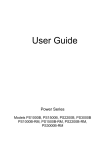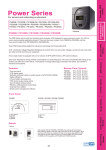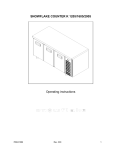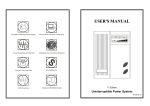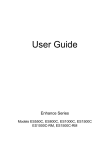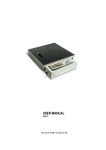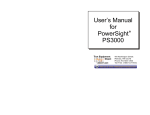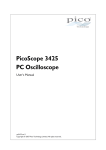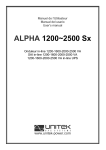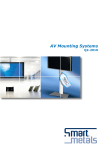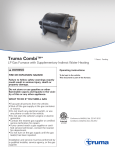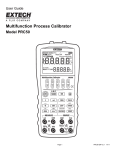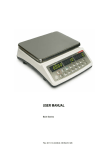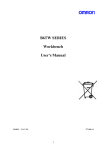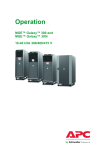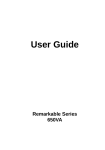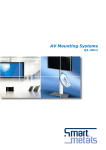Download User Manual - I
Transcript
User’s Guide Power Series Models PS1000B, PS1500B, PS2200B, PS3000B PS1000B-RM, PS2200B-RM, PS3000B-RM For your records The serial number of your UPS is on the rear panel. You should note the serial number in the space provided below. Retain this booklet as a permanent record of your purchase to aid in identification in the event of theft or loss. Model No: Serial No.: Purchase Date: LIMITED WARRANTY What the warranty covers: We warrant this product to be free from defects in material and workmanship during the warranty period. If a product proves to be defective in material or workmanship during the warranty period, we will at our sole option repair or replace the product with a like product. How long the warranty is effective: For accurate warranty period and conditions, please contact local branch offices or your dealers. Who the warranty protects: This warranty is valid only for the first consumer purchaser. What the warranty does not cover: 1. 2. 3. Any product on which the serial number has been defaced, modified or removed. Damage, deterioration or malfunction resulting from: a) Accident, misuse, neglect, fire, water, or other acts of nature, unauthorized product modification, or failure to follow instructions supplied with the product. b) Repair or attempted repair by anyone not authorized. c) The fault is result of accidental damage or damage in transit or transportation, including but not limited to liquid spillage. d) Removal or installation of the product. e) Causes external to the product. f) Use of supplies or parts not meeting our specifications. g) Normal wear and tear. h) Any other cause which does not relate to a product defect. Removal, installation and set-up service charges. Limitation of implied warranties: THERE ARE NO WARRANTIES, EXPRESS OR IMPLIED, WHICH EXTEND BEYOND THE DESCRIPTION CONTAINED HEREIN INCLUDING THE IMPLIED WARRANTY OF MERCHANTABILITY AND FITNESS FOR A PARTICULAR PURPOSE. Exclusion of damages: OUR LIABILITY IS LIMITED TO THE COST OF REPAIR OR REPLACEMENT OF THE PRODUCT. WE SHALL NOT BE LIABLE FOR: 1. DAMAGE TO OTHER PROPERTY CAUSED BY ANY DEFECTS IN THE PRODUCT*, DAMAGES BASED UPON INCONVENIENCE, LOSS OF USE OF THE PRODUCT, LOSS OF TIME, LOSS OF PROFITS, LOSS OF BUSINESS OPPORTUNITY, LOSS OF GOODWILL, LOSS OF DATA, LOSS OF SOFTWARE, COSTS OF SUBSTITUTE EQUIPMENT, INTERFERENCE WITH BUSINESS RELATIONSHIPS, CLAIMS BY THIRD PARTIES, OR OTHER COMMERCIAL LOSS, EVEN IF ADVISED OF THE POSSIBILITY OF SUCH DAMAGES. 2. ANY OTHER DAMAGES, WHETHER INCIDENTAL, CONSEQUENTIAL OR OTHERWISE. 3. ANY CLAIM AGAINST THE CUSTOMER BY ANY OTHER PARTY. Effect of state law: This warranty gives you specific legal rights, and you may also have other rights which vary from state to state. Some states do not allow limitations on implied warranties and/or do not allow the exclusion of incidental or consequential damages, so the above limitations and exclusions may not apply to you. Limitations of Warranty (for Australian States and Territories) The Trade Practices Act 1974 and corresponding State and Territory Fair Trading Acts or legalization of another Government (“the relevant acts”) in certain circumstances imply mandatory conditions and warranties which cannot be excluded. This warranty is in addition to and not in replacement for such conditions and warranties. To the extent permitted by the Relevant Acts, in relation to your product and any other materials provided with the product (“the Goods”) the liability of Opti Australia under the Relevant Acts is limited, at the option of Opti Australia to: • Replacement of the Goods; or • Repair of the Goods; or • Payment of the cost of replacing the Goods; or • Payment of the cost of having the Goods repaired. Opti Australia reserves the right to request proof of purchase upon any warranty claim. Life Support: We do not recommend the use of our UPS products for life support equipment or direct care where failure of a UPS product could cause failure of, or diminished effectiveness of the life support equipment or patient care. EFFECTIVE October 1, 1997 IMPORTANT SAFETY INSTRUCTIONS SAVE THESE INSTRUCTIONS ! THIS MANUAL CONTAINS IMPORTANT SAFETY INSTRUCTIONS. KEEP THIS MANUAL HANDY FOR REFERENCE. • CAUTION: A BATTERY CAN PRESENT A RISK OF ELECTRICAL SHOCK, BURNS FROM HIGH SHORT-CIRCUIT CURRENT, FIRE OR EXPLOSION FROM VENTED GASES. OBSERVE PROPER PRECAUTIONS. • WHEN REPLACING BATTERIES, USE THE SAME NUMBER AND THE FOLLOWING TYPE BATTERIES: SEALED LEAD-ACID MAINTENANCE FREE (PS1000B: 1234W x2) (PS1500B: 1234W x3) (PS2200B: 7.2AH/12V x8) (PS3000B: 1234W x8) (PS1000B-RM: 7.2AH/12V x3)(PS2200B-RM: 1221W x8) (PS3000B-RM: 1221W x8) • PROPER DISPOSAL OF BATTERIES IS REQUIRED. REFER TO YOUR LOCAL CODES FOR DISPOSAL REQUIREMENTS. CAUTION: ! THE UPS CONTAINS VOLTAGES WHICH ARE POTENTIALLY HAZARDOUS. ALL REPAIRS SHOULD BE PERFORMED BY QUALIFIED SERVICE PERSONNEL. THE UPS HAS ITS OWN INTERNAL ENERGY SOURCE (BATTERY). THE OUTPUT RECEPTACLES MAY BE ALIVE EVEN WHEN THE UPS IS NOT CONNECTED TO AN AC SUPPLY. Safe and continuous operation of the UPS depends partially on the care taken by users. Please observe the following precautions. • Do not disassemble the UPS. • Do not attempt to power the UPS from any receptacle except a 2-pole 3-wire grounded receptacle. • Do not place the UPS near water or in environments of excessive humility. • Do not allow liquid or any foreign objects to get inside the UPS. • Do not block air vents on the side of the UPS. • Do not plug appliances, such as hair dryers, into the UPS receptacles. • Do not place the UPS under direct sunshine or close to heat-emitting sources. • This UPS is intended for installation in a temperature controlled, indoor area free of conductive contaminants. • The socket-outlet shall be installed near the UPS and easily accessible. • With the installation of the UPS it should be prevented, that the sum of the leakage current of the UPS and the connected consumer exceeds 3.5mA. • The battery supply should be disconnected in the plus and minus pole at the quick connectors of the battery when maintenance or service work inside the UPS is necessary. • Do not dispose of batteries in a fire, the battery may explode. • Do not open or mutilate the battery or batteries, released electrolyte is harmful to the skin and eyes. • A battery can present a risk of electric shock and high short circuit current. The following precaution should be observed when working on batteries * Remove watches, rings or other metal objects. * Use tools with insulated handles. FEDERAL COMMUNICATIONS COMMISSION (FCC) WARNING: This equipment has been tested and found to comply with the limits for a Class B digital device, pursuant to Part 15 of the FCC rules. These limits are designed to provide reasonable protection against harmful interference in a residential installation. This equipment generates, uses and can radiate radio frequency energy and if not installed and used in accordance with the instructions, may cause harmful interference to radio communications. However there is no guarantee that interference will not occur in a particular installation. If this equipment does cause harmful interference to radio or television reception, which can be determined by turning the equipment off and on, the user is encouraged to try to correct the interference by one or more of the following measures: • Reorient or relocate the receiving antenna. • Increase the separation between the equipment and the receiver. • Connect the equipment into an outlet on a circuit different from that to which the receiver is connected. • Consult the dealer or an experienced radio/TV technician for help. CANADIAN DEPARTMENT OF COMMUNICATIONS (DOC) This equipment does not exceed Class B limits for radio noise emissions from digital apparatus set out in the Radio Interference Regulation of the Canadian Department of Communications. Operation in a residential area may cause Unacceptable interference to radio and TV reception requiring the owner or operator to take whatever steps are necessary to correct the interference. PS1000B/ PS1500B/ PS2200B/ PS3000 1 TABLE OF CONTENTS 1. INTRODUCTION 1.1 1.2 1.3 1.4 1.5 1.6 1.7 2. Overview Sinewave Output Smart Buck and Boost Line Conditioning User Replaceable Battery Design Advanced Interface to Communicate with Computer User Configurable Settings Data-Line Surge Protection 2 2 2 3 3 3 3 UPS CONTROLS 2.1 2.2 2.3 2.4 2.5 2.6 2.7 2.8 2.9 2.10 2.11 3. External Views Front Panel Rear Panel On Button Off Button Select Button Load Percentage Bar Graph Battery Capacity bar graph Fault code Status Indication Communication Port Start-Up On Battery Data-Line Surge Suppression 4 4 5 6 6 7 7 7 7 7 8 8 8 INSTALLATION AND OPERATION 3.1 3.2 3.3 3.4 3.5 3.6 3.7 4. Unpacking and Inspection Placement Determining How Much Equipment You Can Connect to Your UPS Powering Up Your UPS Connecting Your Equipment to the UPS Operation and Functional Test Storage Instructions 9 9 9 10 10 12 12 SPECIFICATIONS 4.1 4.2 4.3 5. Electrical Specifications Mechanical Specifications Environmental Specifications 13 15 15 TROUBLESHOOTING 5.1 6. Troubleshooting Chart 16 USER REPLACEABLE BATTERY 6.1 6.2 Warning Battery Replacement Procedure 17 18 2 1. PS1000B / PS1500B/ PS2200B / PS3000B INTRODUCTION 1.1 Overview These models are advanced line-interactive true sinewave uninterruptible power systems (UPS) designed to prevent spikes, surges, sags, transients and blackouts from reaching your sensitive equipment. Your equipment may include such items as computers and computerized instruments to telecommunication systems. When AC power is present, the UPS filters and conditions the power continuously. When AC power fails, the unit employs its internal maintenance-free battery to supply back-up power without interruption. 1.2 Sinewave Output The output voltage is a true sinewave, the same waveform that your equipment gets from the wall outlet. This provides guaranteed compatibility with all types of loads and even the most sensitive equipment. 1.3 Smart Buck and Boost Line Conditioning The voltage from your AC power source can fluctuate above and below the standard rating. This microprocessor controlled UPS provides line conditioning via both buck (step-down voltage) and boost (step-up voltage) functions. For example, if your normal voltage is 120V and the voltage fluctuates up to 132V, the buck function in your UPS will step it down so that your equipment receives approximately 120V. If the voltage fluctuates down to 108V, the boost function will step it up so that your equipment receives approximately 120V. This provides your equipment with excellent voltage regulation with less possibility for the UPS to drain its internal battery. PS1000B/ PS1500B/ PS2200B/ PS3000 3 1.4 User Replaceable Battery Design The battery is the most critical part in a UPS. The average lifetime of a battery is between 3 and 5 years. The special user-replaceable battery design of this UPS provides significant savings and gives the UPS an almost unlimited life. You can replace the battery very easily, and without turning off your UPS or the equipment it is protecting. 1.5 Advanced Interface to Communicate with Computer Many UPSs provide only a basic power failure warning. These models, together with software also provide you with important operating information. From your computer screen, you can know input/output voltage and current, frequency, battery voltage, etc., and analyze power problems. If software is not part of your UPS package, you can purchase it from your local dealer. 1.6 Schedule Shutdown & Startup Using software you can locally or remotely control the shutdown and startup of equipment connected to a UPS. A customized schedule can be developed to meet your specific requirements. 1.7 Data-Line Surge Protection The built-in data-line surge suppression on the rear panel completes your system protection. It provides an easy way to protect a network (RJ45) or modem (single line phone) connection from hazardous spikes. 4 PS1000B / PS1500B/ PS2200B / PS3000B 2. UPS CONTROLS 2.1 External Views MODEL: PS1000B, PS1500B, PS2200B, PS3000B Front Panel MODEL: PS1000B-RM, PS2200B-RM, PS3000B-RM PS1000B/ PS1500B/ PS2200B/ PS3000 Rear Panel MODEL: PS1000B MODEL: PS1500B MODEL: PS2200B, PS3000B 5 6 PS1000B / PS1500B/ PS2200B / PS3000B MODEL: PS1000B-RM PS2200B-RM, PS3000B-RM 2.2 On Button 1. When the UPS is off and AC power is present, press the On button for 1~2 seconds to turn on the UPS. UPS can be turned on even when AC power is not present. 2. Pressing the On Button when AC power is available causes the UPS to test itself by switching to its internal battery for a few seconds. We recommend you close all your open files before initiating this test. 3. If AC power fails, the UPS warns you with an audible alarm. To silence the alarm, press the On Button. When the battery starts to get low, the audible alarm will return and beep faster. 2.3 Off Button The Off Button has two steps to shutdown UPS : 1. 2. Pressing the Off Button when AC power is available causes the UPS into the sleep mode. We recommend you close all your open files before initiating this test. Pressing the Off Button 3 seconds when AC power fails causes the UPS into sleep mode. Then pressing the Off Button 3 seconds causes the UPS to shutdown completely. PS1000B/ PS1500B/ PS2200B/ PS3000 7 2.4 Select Button The relevant value appears on the upper screen. There are several parameters can be selected Output voltage display Input voltage display Input frequency Temperature inside the UPS Output frequency Load level at percent 2.5 Load Percentage Bar Graph The LCD display on the front panel shows the current load percentage. From 0 to 100 percent, the percentage of the UPS’s maximum power capacity being drawn by your connected equipment is shown. 2.6 Battery Capacity bar graph The LCD display on the front panel shows the percentage of the battery capacity. From zero to 100%, the present charge of the UPS’s batteries is shown. 2.7 Fault code The relevant value appears at the upper screen. There are two kinds of fault modes can be displayed. Err0: UPS Fault Err1: Warning of overload (exceeding 120%) 2.8 Status Indication UPS Status Indication “LINE” indicator: The indicator illuminates when the line input voltage is normal. "BY PASS" indicator: The indicator illuminates when the loads are supplied from the utility power, through the by-pass direction. are supplied from the utility power, through the buck direction. are supplied from the utility power, through the boost direction. "INV": The indicator illuminates when the power is supplied from the inverter circuit. “BACKUP” indicator : The indicator illuminates when the power is supplied from the batteries. “FAULT” indicator: It shows something wrong concerning about the UPS. 8 PS1000B / PS1500B/ PS2200B / PS3000B 2.9 Communication Port The communication port on the rear panel of the UPS allows for connection to a host computer. When used with software communication software you will have access to important operating information. From your computer screen, you can monitor input/output voltage, AC frequency, battery voltage, etc., and analyze power problems. Software will also initiate automatic graceful shutdowns during extended power failures. If software and a communication cable are not included in your UPS package, you can purchase it from your local dealer. 2.10 Start-Up On Battery When ac input power is not available and the UPS is turned off, the Start-Up on Battery function can be used to power up your equipment. Do not connect too much equipment to the UPS during the Start-Up on Battery operation. 1. Disconnect the input ac power cord from the rear panel of the UPS. 2. Press the on/off button on the front panel until the UPS beeps. 3. After you have finished using the UPS, press the on/off button to turn off the UPS. 2.11 Data-Line Surge Suppression The data-line surge suppression on the rear panel provides an easy way to protect a network (RJ45) or modem (RJ11) connection from hazardous spikes. Connect a 10/Base-T network cable or a single line telephone into the “Line” socket. To complete the connection, connect another network cable or telephone line into the “System” socket. The network cable and telephone line are optional accessories, which may be purchased from your local dealer. PS1000B/ PS1500B/ PS2200B/ PS3000 9 3. INSTALLATION AND OPERATION Before installation, please read and understand the following instructions: 3.1 Unpacking and Inspection Examine the packing carton for damage. Notify the carrier immediately if damage is observed. 3.2 Placement 1. This unit is intended for indoor use only. Although your UPS is very rugged, its internal components are not sealed from the environment. 2. 4. The UPS must be installed in a protected environment away from heatemitting appliances such as a radiator or heater. Do not install this product where excessive moisture is present. The location should provide adequate air flow around the UPS with one inch minimum clearance on all sides for proper ventilation. 3.3 Determining How Much Equipment You Can Connect to Your UPS 1. Make a list of all equipment that requires protection. 2. Each piece of equipment has voltage and current (VA) ratings printed on the back label (see examples below). Your equipment may have a voltage rating such as 88-264V. Since the standard voltage in the United States is 120V, you should use 120V in your calculations. 10 PS1000B / PS1500B/ PS2200B / PS3000B ViewSonic G810 120V 2.7A 50 / 60 Hz SN: Q771515388 3. Computer Co Pentium Pro 200MHz 120V 2.0A 50/60 Hz SN: 123456 Multiply the voltage and current of each piece of equipment (VA requirements); for example, 120V x 2.7A = 324VA, 120V x 2.0A = 240VA. Add up the VA requirements for each device; for example, 324VA + 240VA = 564VA. 4. Make sure that your UPS has at least as much VA capacity as your equipment requires. 3.4 Powering Up Your UPS 1. For 110/120V versions, connect the power cord to a verified grounded 3wire receptacle. For 2X0V versions, please refer to Sec 3.5 . 2. Power up the UPS by press the On/Off button for 3 seconds on the front panel. 3. We recommend that you charge the battery for six (6) hours before first use of your UPS. You may use the UPS immediately without charging the battery, but the backup time may be less than the rating. The UPS recharges the battery automatically whenever AC power is available. PS1000B/ PS1500B/ PS2200B/ PS3000 11 3.5 Connecting Your Equipment to the UPS 1. For all UPS models except the 2xxV versions: connect the power cord(s) of your computer equipment to the output receptacle(s) of the UPS. Switch on the computer equipment. 2. For 2xxV versions, as shown in the illustration below: connect the input power cord of your computer equipment to the inlet of the UPS and the wall socket. Use the power cord supplied with the UPS to connect from the outlet of the UPS to your equipment. Switch on the computer equipment. 12 PS1000B / PS1500B/ PS2200B / PS3000B 3. DO NOT PLUG LASER PRINTERS INTO THE UPS BECAUSE THEY TYPICALLY DRAW TOO MUCH POWER 3.6 Operation and Functional Test 1. 2. Plug in the AC input cord to the rear panel and turn on the UPS by pressing the “On/Off” switch for 3 seconds. The UPS will beep and the front panel Normal Mode LED will light. The UPS may be overloaded if the buzzer sounds continuously and the Overload LED lights. Unplug the least critical devices, such as a printer, etc… If the buzzer is still sounding, the battery or UPS may be faulty. Contact your local dealer for assistance. Note: Backup all unsaved files before you perform the following functional test. 3. To test the backup function, you may unplug the power cord of the UPS or simply press the On Button on the front panel. During this test, observe that your equipment operates properly and without interruption. If you leave your UPS on continuously, it is a good idea to perform a “Test” at least once a month. If you unplug the power cord, all models will beep once every 4 seconds. You can press the Test Button to silence the alarm. The Battery Mode LED will light. Plug the power cord back in after a few seconds. If you press the On Button, the Battery Mode graph will light momentarily. 3.7 Storage Instructions For extended storage in moderate climates, the battery should be charged for 12 hours every 3 months. Repeat it every 2 months in high temperature locations. Plug in the power cord. The UPS does not need to be turned on to charge. PS1000B/ PS1500B/ PS2200B/ PS3000 13 4. SPECIFICATIONS 4.1 Electrical Specifications Product Name Frequency (Hz) PS1000B 50/ 60 PS1500B 50/ 60 PS2200B 50/ 60 PS3000B 50/ 60 Product Name Frequency (Hz) PS1000B-RM 50/60 PS2200B-RM 50/60 PS3000B-RM 50/60 Rated Voltage (V) 100/ 110/ 120V 220/ 230/ 240V 100/ 110/ 120V 220/ 230/ 240V 100/ 110/ 120V 220/ 230/ 240V 100/ 110/ 120V 220/ 230/ 240V VA/ W Capacity Rated Voltage (V) 100/ 110/ 120V 220/ 230/ 240V 100/ 110/ 120V 220/ 230/ 240V 100/ 110/ 120V 220/ 230/ 240V VA / W Capacity 1000/ 700 1500/ 1050 2200/ 1760 3000/ 2400 1000/ 700 2200/ 1540 3000/ 2100 Input/Output Voltage Version 1xxV 2xxV AC Line Voltage Lower Limit Rated Voltage-25% Rated Voltage-25% Upper Limit Rated Voltage+25% Rated Voltage+25% Output voltage regulation: ± 7% (Backup Mode), ± 10% (AC Mode) Input/Output Frequency Input (AC mode) Output (Inverter mode) 45Hz – 55 Hz / 55 Hz – 65 Hz 50 Hz / 60 Hz ± 0.1 Hz Wave Form AC Mode Back Up Mode Sine wave Sine wave 14 PS1000B / PS1500B/ PS2200B / PS3000B Transfer time Power Failure AC ⇒ Inverter 4 ms (typical) Spike/Surge protection Version 100/110/120V 220/230/240V Continuous Voltage Vrms 175V 330V Single pulse 8/20us Imax Joules 6,000A 1050 6,000A 1050 Data-Line Surge Suppression Telephone Line Surge Protection 10 Base-T Protection Let Through Rating +/- 6KV Peak (1.2µS/50 Waveform) <1% (From 6KV/125A Normal Mode Surge) Audible Alarm Beep every 4 seconds Beep every second Continuous buzzer Continuous buzzer Battery discharge at power failure Battery approaches final discharge Overload UPS faulty Battery and Charger Battery type: Maintenance-free sealed-lead acid. Recharge time 6 to 8 hours typical from total discharge. (The UPS may be used immediately after discharge but will provide shorter backup time) Battery Specifications PS1000B DC voltage 24V 12V Type 34W Quantity 2 Recharge time 4 Hours DC voltage Type Quantity Recharge time PS1000B-RM 36V 12V 7.2AH 3 4 Hours PS1500B 36V 12V 34W 3 4 Hours PS2200B 48V 12V 7.2AH 8 4 Hours PS2200B-RM 48V 12V 21W 8 4 Hours PS3000B 48V 12V 34W 8 4 Hours PS3000B-RM 48V 12V 21W 8 4 Hours PS1000B/ PS1500B/ PS2200B/ PS3000 15 4.2 Mechanical Specifications: Product Name PS1000B PS1500B PS2200B PS2200B-BP PS3000B PS3000B-BP Product Name PS1000B-RM PS2200B-RM PS3000B-RM Dimensions L × W × H (mm) 445 x 140 x 200 445 x 170 x 215 445 x 170 x 215 445 x 170 x 215 445 x 170 x 215 445 x 170 x 215 Net 15.7 22.2 19.9 25.6 20.2 27.1 Weight (Kg) Shipping 17.6 25.1 21.7 27.2 21.9 28.6 Dimensions L × W × H (mm) 550 x 428 x 84 620 x 428 x 84 620 x 428 x 84 Net 22.6 40.7 40.7 Weight (Kg) Shipping 27.1. 46.4 46.4 4.3 Environmental Specifications: Temperature Humidity Altitude Operating 0 ~ 40°C (32° ~ 104°F) 0 ~ 95% (non-condensing) 3,000 m (10,000 ft) (Max.) Storage and Shipment -20° ~ +60°C (-4° ~ +140°F) 0 ~ 95% (non-condensing) 12,000 m (40,000 ft) (Max.) 16 PS1000B / PS1500B/ PS2200B / PS3000B 5. TROUBLESHOOTING The TROUBLESHOOTING CHART on the next page covers most of the difficulties that you may encounter under normal working conditions. If the UPS fails to operate properly, please review the following steps before calling the repair center: 1. Is the UPS plugged into a proper working outlet? 2. Is the line voltage within the rating specified? 3. Does the circuit breaker on the rear panel need to be reset? 5.1 Troubleshooting Chart Problem UPS does not power up and has no audible alarm Possible Cause On/Off button is not pressed long enough. No incoming line or very low or very high line voltage. UPS input power cord is not plugged in. Rear panel circuit breaker is tripped. UPS over load LED light & continuous audible alarm. UPS is overloaded. Low Replace Battery LED is light Battery voltage is too low, or the battery is dead. Site Wiring Fault LED is on. Site wiring problem Back-up time is less than the rating. Battery is not fully charged or the battery is dead. UPS is normal but the computer won’t turn on. Computer input power cord is loose or not connected. Wrong interface cable. Software communication not working The serial port of the computer has not been configured properly. The I/O card is defective Corrective Action Press the On/Off button until UPS turns on Check the wall socket and test the input line voltage. Plug in input power cord. Reduce the load and reset the circuit breaker. Remove the least critical devices from the load. Recharge the battery for more than 4 hours and reset the UPS. If the LED is still lit, replace battery. Call an electrician to check your wiring. Recharge the battery for 6 hours and retest the backup time. Reconnect computer input power cord. Purchase the correct one from your distributor. Check to see that the serial port is enabled in the CMOS settings. Also check for IRQ conflicts and make sure the settings match those of OPTISAFE™+. Replace I/O card. PS1000B/ PS1500B/ PS2200B/ PS3000 17 6.USER REPLACEABLE BATTERY The Batteries inside this UPS should last from between 3 to 5 years. If you suspect that the batteries are weak, allow the UPS to charge the batteries for at least six hours and then test the backup time. If the UPS still does not provide adequate backup time, follow the procedures below to replace the batteries. Please read section 6.1 before performing the procedure in sections 6.2 or 6.3. 6.1 WARNING Servicing of batteries should always be performed or supervised by personnel knowledgeable of batteries and required precautions. Please read the following cautions before replacing the batteries. Keep unknowledgeable (i.e., unauthorized) personnel away from the batteries. CAUTION: Except for the battery, the unit contains no user serviceable parts. Repairs should be performed only by factory trained service personnel. CAUTION: A battery can present a risk of electrical shock and high shortcircuit current. The following precautions should be observed when working on batteries: (1) Remove watches, rings, or other metal objects. (2) Use tools with insulated handles. CAUTION: Do not dispose of batteries in a fire. The batteries may explode. CAUTION: Do not open or mutilate batteries. They contain an electrolyte which is toxic and harmful to the skin and eyes. CAUTION: When replacing batteries, use the same number and the following type batteries: sealed Lead-Acid Maintenance Free (PS1000B: 1234W x2) (PS1500B: 1234W x3) (PS2200B: 7.2AH/12V x8) (PS3000B: 1234W x8) (PS1000B-RM: 7.2AH/12V x3)(PS2200B-RM: 1221W x8) (PS3000B-RM: 1221W x8) 18 PS1000B / PS1500B/ PS2200B / PS3000B 6.2 Battery Replacement Procedure PS-1000B Changing the batteries in your UPS is a safe and easy procedure. Since the battery is isolated from the AC input you may leave your UPS and computer or other equipment on during the following procedure. Please note that if you choose to leave the UPS on when the battery is removed, it will not be able to power your equipment if a power failure occurs. Please read the cautions in section 6.1 before performing the following steps. 1. Remove the two screws on the front panel. 2. Pull and open the cover. 3. Remove the screws of the battery retaining plate. 4. Pull out the battery. 5. Disconnect the two wires connecting the battery pack to the UPS. 6. Connect the wires to the new battery pack making sure that the red wire is connected to the red battery terminal and the black wire is connected to the black battery terminal. 7. Push the new battery pack into place. 8. Reposition the battery retaining plate and tighten the screws. 9. Slide the front panel back into place. 10. Tighten the two small screws on the bottom of the front panel. PS1000B/ PS1500B/ PS2200B/ PS3000 19 PS-1500B/ 2200B/ 3000B Changing the batteries in your UPS is a safe and easy procedure. Since the battery is isolated from the AC input you may leave your UPS and computer or other equipment on during the following procedure. Please note that if you choose to leave the UPS on when the battery is removed, it will not be able to power your equipment if a power failure occurs. Please read the cautions in section 6.1 before performing the following steps. 1. Remove the two screws on the front panel. 2. Pull and open the cover. 3. Remove the screws of the battery retaining plate. 4. Pull out the battery. 5. Disconnect the two wires connecting the battery pack to the UPS. 6. Connect the wires to the new battery pack making sure that the red wire is connected to the red battery terminal and the black wire is connected to the black battery terminal. 7. Push the new battery pack into place. 8. Reposition the battery retaining plate and tighten the screws. 9. Slide the front panel back into place. 10. Tighten the two small screws on the bottom of the front panel 20 PS1000B / PS1500B/ PS2200B / PS3000B PS1000B-RM/ PS2200B-RM/ PS3000B-RM Changing the batteries in your UPS is a safe and easy procedure. Since the battery is isolated from the AC input you may leave your UPS and computer or other equipment on during the following procedure. Please note that if you choose to leave the UPS on when the battery is removed, it will not be able to power your equipment if a power failure occurs. Please read the cautions in section 6.1 before performing the following steps. 1. Remove the front panel. 2. Remove the screws of the battery box. 3. Pull out the battery box. 4. Change and Slide the new battery box into the UPS. 5. Screw the battery box on the case 6. Close the cover.




























